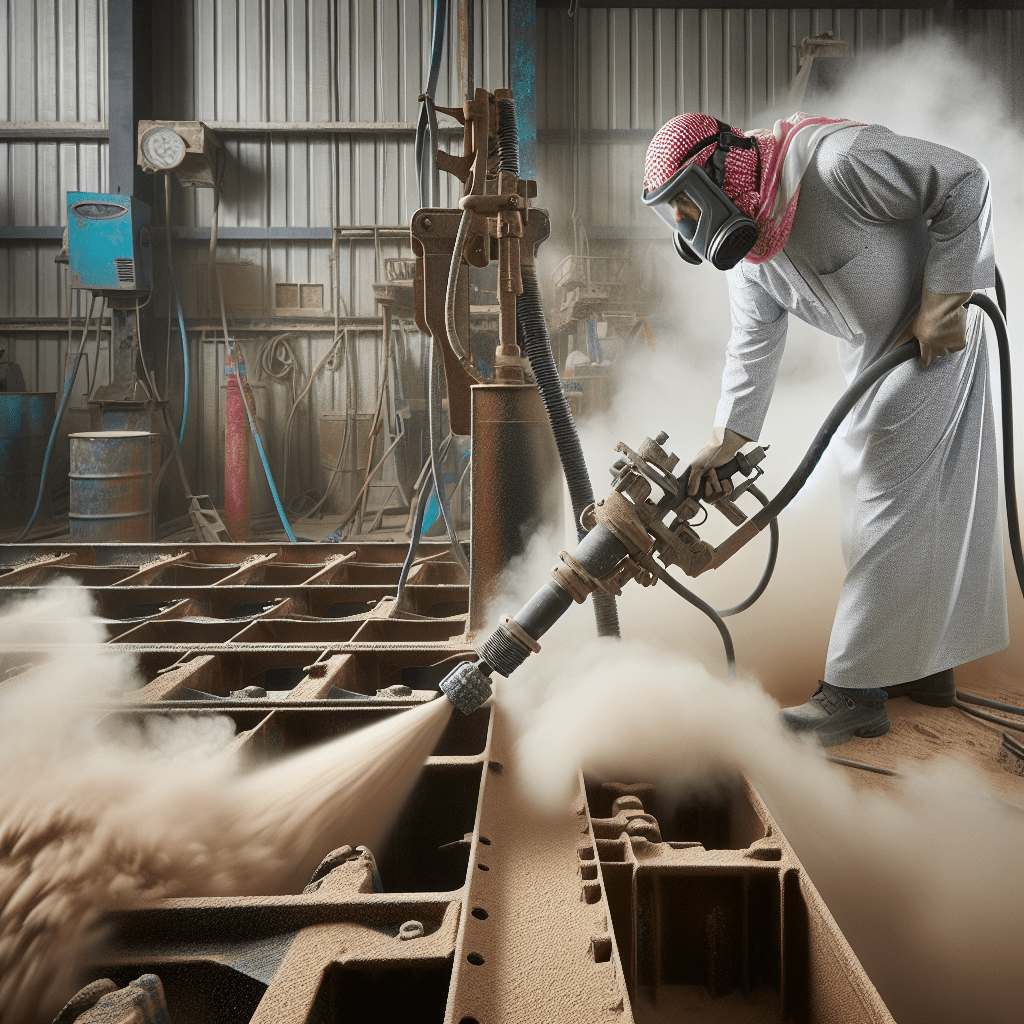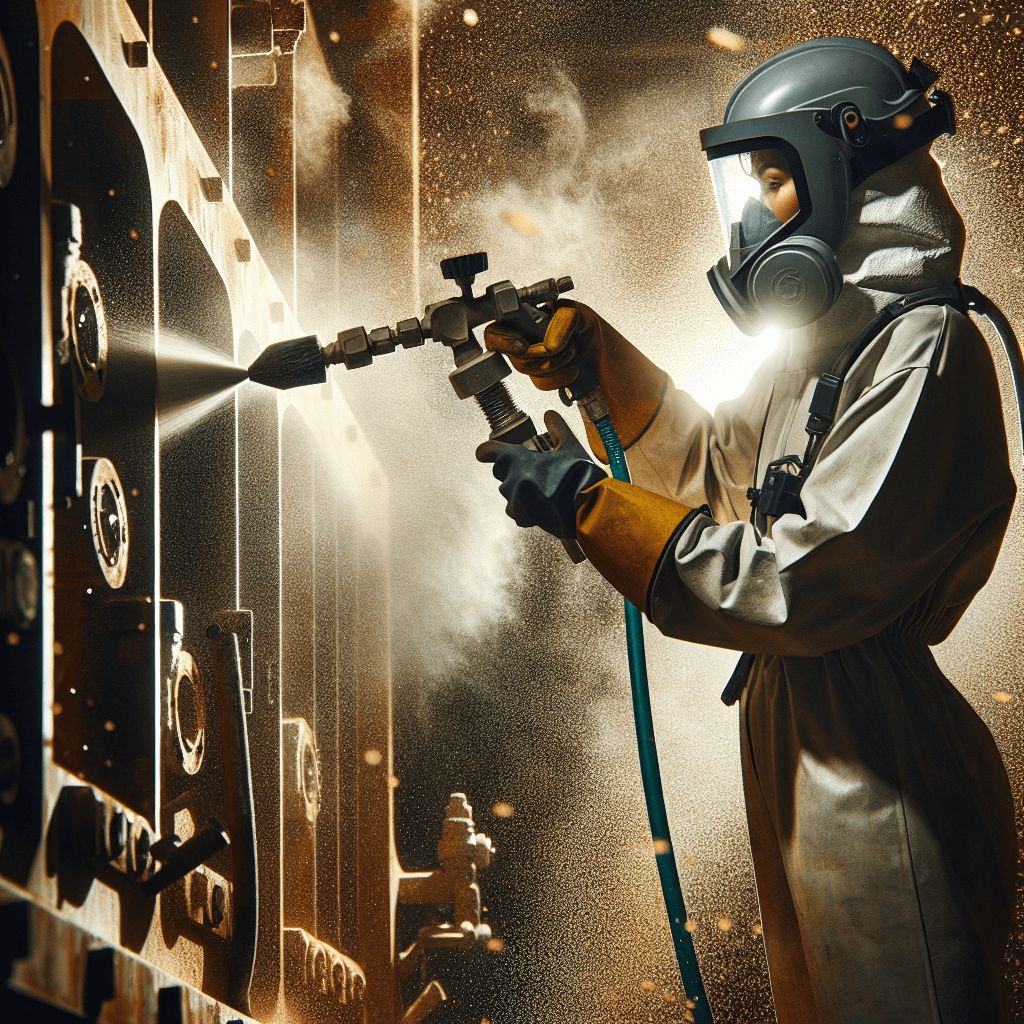Abrasive Blasting
“Unleash the Power of Precision with Abrasive Blasting”
Introduction
Abrasive blasting, also known as sandblasting, is a technique used to clean, polish, or shape surfaces by forcibly propelling abrasive materials against them. This process involves the use of compressed air or water to propel abrasive particles at high speeds, effectively removing unwanted substances or altering the surface texture. Abrasive blasting is commonly used in various industries, such as automotive, construction, and manufacturing, for tasks like removing rust, paint, or scale, preparing surfaces for coating or bonding, and creating a desired surface finish.
Causes and Risk Factors of Abdominal Aortic Aneurysm
Abdominal Aortic Aneurysm — see Aortic Aneurysm.
An abdominal aortic aneurysm (AAA) is a potentially life-threatening condition that occurs when the wall of the aorta, the largest artery in the body, weakens and bulges outwards. This bulge can become dangerous if it ruptures, leading to severe internal bleeding and potentially fatal consequences. Understanding the causes and risk factors of AAA is crucial in order to prevent its occurrence and manage the condition effectively.
One of the primary causes of AAA is atherosclerosis, a condition characterized by the buildup of plaque in the arteries. Over time, this plaque can weaken the walls of the aorta, making it more susceptible to aneurysm formation. High blood pressure, another common risk factor for AAA, puts additional strain on the arterial walls, increasing the likelihood of an aneurysm developing. Smoking, a well-known contributor to cardiovascular disease, is also a significant risk factor for AAA. The chemicals in tobacco smoke can damage the walls of the aorta, making them more prone to aneurysm formation.
Age and gender also play a role in the development of AAA. The risk of developing an abdominal aortic aneurysm increases with age, particularly in individuals over the age of 65. Men are more likely to develop AAA than women, with the prevalence being four to five times higher in males. Hormonal differences between men and women may contribute to this disparity, but further research is needed to fully understand the underlying mechanisms.
Genetics and family history are important factors to consider when assessing the risk of AAA. Individuals with a first-degree relative, such as a parent or sibling, who has been diagnosed with an abdominal aortic aneurysm are at a higher risk of developing the condition themselves. This suggests a genetic component to AAA, although the specific genes involved have not yet been identified. Research in this area is ongoing, and a better understanding of the genetic factors involved may lead to improved screening and prevention strategies.
Certain medical conditions can also increase the risk of AAA. Individuals with a history of other types of aneurysms, such as thoracic aortic aneurysms, are more likely to develop an abdominal aortic aneurysm. Additionally, individuals with connective tissue disorders, such as Marfan syndrome or Ehlers-Danlos syndrome, have a higher risk of developing AAA. These conditions weaken the connective tissues in the body, including those in the arterial walls, making aneurysm formation more likely.
In conclusion, understanding the causes and risk factors of abdominal aortic aneurysm is crucial for prevention and management. Atherosclerosis, high blood pressure, and smoking are common contributors to AAA. Age, gender, genetics, and family history also play a role in an individual’s risk of developing the condition. Medical conditions such as other types of aneurysms and connective tissue disorders further increase the risk. By identifying these risk factors and implementing appropriate preventive measures, such as lifestyle modifications and regular screenings, individuals can reduce their chances of developing an abdominal aortic aneurysm and potentially avoid the life-threatening complications associated with it.
The Importance of Abortion Surveillance in Public Health
Abortion is a highly controversial topic that has been debated for decades. It is a complex issue that involves personal beliefs, ethics, and legal considerations. However, regardless of one’s stance on the matter, it is crucial to recognize the importance of abortion surveillance in public health.
Abortion surveillance refers to the systematic collection, analysis, and interpretation of data related to induced abortions. This data provides valuable insights into the prevalence, characteristics, and outcomes of abortions, which are essential for informing public health policies and programs.
One of the primary reasons why abortion surveillance is crucial is because it helps monitor trends and patterns in abortion rates. By collecting data on the number of abortions performed, the age and race of the women seeking abortions, and the gestational age at which the procedures are performed, public health officials can identify any changes or shifts in abortion practices. This information can then be used to develop targeted interventions and strategies to reduce unintended pregnancies and promote reproductive health.
Furthermore, abortion surveillance plays a vital role in assessing the safety and quality of abortion services. By monitoring the complications and adverse events associated with abortions, public health authorities can identify any potential risks or gaps in the provision of safe and legal abortion care. This information can then be used to improve the quality of services, ensure adherence to clinical guidelines, and protect the health and well-being of women seeking abortions.
Abortion surveillance also helps in understanding the social and economic factors that influence abortion decisions. By collecting data on the reasons why women choose to have abortions, such as financial constraints, lack of access to contraception, or personal circumstances, policymakers can develop targeted interventions to address these underlying issues. This can include initiatives to improve access to affordable contraception, comprehensive sex education, and support services for women facing unintended pregnancies.
Moreover, abortion surveillance is essential for monitoring the impact of abortion restrictions and policies. By collecting data on the availability and accessibility of abortion services, as well as any legal barriers or restrictions, public health officials can assess the impact of these policies on women’s reproductive health outcomes. This information can then be used to advocate for evidence-based policies that protect women’s rights and ensure access to safe and legal abortion care.
In conclusion, abortion surveillance is a critical component of public health. It provides valuable data on the prevalence, characteristics, and outcomes of abortions, which are essential for informing policies and programs aimed at reducing unintended pregnancies and promoting reproductive health. By monitoring trends, assessing safety and quality, understanding social and economic factors, and evaluating the impact of policies, abortion surveillance plays a vital role in protecting women’s health and rights. Regardless of one’s personal beliefs on abortion, it is crucial to recognize the importance of this surveillance in ensuring the well-being of women and promoting public health.
The Benefits of Abrasive Blasting in Industrial Cleaning
Abrasive blasting, also known as sandblasting, is a highly effective method used in industrial cleaning. It involves propelling abrasive materials at high speeds to clean, smooth, or shape a surface. This technique has gained popularity in various industries due to its numerous benefits.
One of the key advantages of abrasive blasting is its ability to remove tough contaminants and coatings from surfaces. Whether it’s rust, paint, or scale, abrasive blasting can effectively strip away these unwanted substances, leaving the surface clean and ready for further treatment. This makes it an ideal choice for preparing surfaces before painting, coating, or welding.
In addition to its cleaning capabilities, abrasive blasting also offers the advantage of surface profiling. By adjusting the type and size of the abrasive material used, operators can create different surface profiles to enhance adhesion. This is particularly important in industries such as automotive, aerospace, and construction, where strong bonding between surfaces is crucial.
Another benefit of abrasive blasting is its versatility. It can be used on a wide range of materials, including metals, concrete, wood, and even delicate surfaces like glass. This makes it a valuable tool in various industries, from manufacturing and construction to restoration and maintenance. With the right equipment and expertise, abrasive blasting can be tailored to suit specific cleaning requirements, ensuring optimal results.
Furthermore, abrasive blasting is a highly efficient method that saves both time and money. Compared to traditional cleaning methods, such as manual scrubbing or chemical treatments, abrasive blasting can complete the task in a fraction of the time. This increased productivity translates into cost savings for businesses, as less labor and fewer resources are required to achieve the desired results.
Moreover, abrasive blasting is an environmentally friendly option for industrial cleaning. Unlike chemical cleaning agents that can be harmful to the environment, abrasive blasting relies on mechanical force to clean surfaces. The abrasive materials used can be recycled and reused, reducing waste and minimizing the impact on the environment. Additionally, the absence of chemicals means that there are no harmful fumes or residues left behind, making it a safer choice for both workers and the surrounding environment.
Lastly, abrasive blasting offers the advantage of versatility in terms of equipment options. There are various types of abrasive blasting equipment available, ranging from portable units for small-scale projects to large-scale systems for industrial applications. This allows businesses to choose the most suitable equipment based on their specific needs and budget.
In conclusion, abrasive blasting is a highly beneficial method for industrial cleaning. Its ability to remove tough contaminants, create surface profiles, and work on a wide range of materials makes it a versatile choice for various industries. Additionally, its efficiency, cost-effectiveness, and environmental friendliness further contribute to its appeal. With these advantages in mind, it’s no wonder that abrasive blasting has become a popular choice for businesses seeking effective and efficient cleaning solutions.
Common Applications of Abrasive Blasting in Construction and Manufacturing
Abrasive blasting, also known as sandblasting, is a widely used technique in the construction and manufacturing industries. It involves propelling abrasive materials at high speeds to clean, smooth, or shape surfaces. This process has numerous applications and is favored for its efficiency and effectiveness.
One common application of abrasive blasting is surface preparation. Before painting or coating a surface, it is crucial to remove any existing paint, rust, or corrosion. Abrasive blasting is the go-to method for this task, as it can quickly and thoroughly strip away unwanted materials. By creating a clean and smooth surface, abrasive blasting ensures that the new paint or coating adheres properly, resulting in a longer-lasting finish.
Another application of abrasive blasting is in the restoration of old structures. Over time, buildings and monuments can become weathered and damaged. Abrasive blasting can be used to remove dirt, grime, and other contaminants from the surface, revealing the original beauty of the structure. Additionally, abrasive blasting can be used to repair and restore damaged areas by removing deteriorated materials and preparing the surface for repairs.
In the manufacturing industry, abrasive blasting is commonly used for surface finishing. Whether it is metal, plastic, or glass, abrasive blasting can create a desired texture or finish on the surface. This technique is particularly useful for creating a matte or rough surface that improves grip or enhances the appearance of the product. Additionally, abrasive blasting can be used to remove burrs or sharp edges from metal parts, ensuring their safety and functionality.
Abrasive blasting is also employed in the construction of new structures. When constructing concrete buildings or bridges, it is essential to achieve a strong bond between the concrete and any reinforcing materials, such as steel bars. Abrasive blasting can be used to roughen the surface of the steel bars, creating a better grip for the concrete. This process, known as abrasive blast cleaning, increases the surface area of the steel, allowing for a stronger bond and ultimately improving the structural integrity of the construction.
Furthermore, abrasive blasting is used in the removal of graffiti and other unwanted markings. Vandalism is a common problem in urban areas, and abrasive blasting provides an effective solution for removing graffiti from various surfaces. By propelling abrasive materials at high speeds, graffiti can be stripped away without causing damage to the underlying surface. This method is not only efficient but also environmentally friendly, as it eliminates the need for harmful chemicals or solvents.
In conclusion, abrasive blasting is a versatile technique with numerous applications in the construction and manufacturing industries. Whether it is for surface preparation, restoration, surface finishing, or graffiti removal, abrasive blasting offers an efficient and effective solution. Its ability to quickly and thoroughly clean, smooth, or shape surfaces makes it a favored method among professionals. With its wide range of applications, abrasive blasting continues to play a vital role in various industries, ensuring the quality and longevity of structures and products.
Different Types of Abrasives Used in Blasting Processes
Different Types of Abrasives Used in Blasting Processes
When it comes to blasting processes, choosing the right abrasive is crucial. Abrasives are materials used to remove unwanted surface contaminants or shape a surface through the process of blasting. There are various types of abrasives available, each with its own unique properties and applications. In this article, we will explore some of the different types of abrasives commonly used in blasting processes.
One of the most commonly used abrasives is sand. Sandblasting, as the name suggests, involves propelling sand particles at high speeds to clean or shape a surface. Sand is readily available and relatively inexpensive, making it a popular choice for many applications. However, sandblasting with silica sand can pose health risks due to the inhalation of silica dust. As a result, alternative abrasives have gained popularity in recent years.
One such alternative is garnet. Garnet is a natural mineral that is non-toxic and environmentally friendly. It is known for its high hardness and durability, making it an excellent choice for abrasive blasting. Garnet is often used in applications where a clean and precise finish is required, such as in the aerospace and automotive industries. It is also commonly used in waterjet cutting, where a fine abrasive is needed to cut through materials without causing heat damage.
Another popular abrasive is aluminum oxide. Aluminum oxide is a synthetic abrasive that is known for its toughness and versatility. It is widely used in blasting processes due to its ability to remove surface contaminants effectively. Aluminum oxide is available in various grit sizes, allowing for different levels of surface roughness. It is commonly used in applications such as rust removal, paint stripping, and surface preparation for painting or coating.
Steel shot and steel grit are abrasives made from steel and are commonly used in shot blasting processes. Shot blasting involves propelling small steel particles at high speeds to clean or strengthen a surface. Steel shot is round in shape and is used primarily for cleaning and peening applications. On the other hand, steel grit is angular in shape and is used for more aggressive cleaning and surface preparation. Both steel shot and steel grit are durable and can be recycled, making them cost-effective options for many industries.
In addition to these abrasives, there are also specialty abrasives available for specific applications. For example, crushed glass is often used for delicate surfaces or where low dust levels are required. Walnut shells are another alternative abrasive that is commonly used for gentle cleaning and polishing. These specialty abrasives offer unique properties that make them suitable for specific tasks.
In conclusion, choosing the right abrasive is essential for achieving the desired results in blasting processes. Sand, garnet, aluminum oxide, steel shot, and steel grit are some of the commonly used abrasives in various industries. Each abrasive has its own unique properties and applications, allowing for a wide range of blasting options. Additionally, specialty abrasives offer alternatives for specific tasks. By understanding the different types of abrasives available, one can make an informed decision and ensure successful blasting processes.
How to Choose the Right Abrasive Blasting Equipment for Your Project
Abortion Surveillance
Abortion is a highly controversial topic that has been the subject of intense debate for decades. It is a complex issue that involves a range of ethical, moral, and legal considerations. In order to better understand the prevalence and patterns of abortion, many countries have implemented abortion surveillance systems. These systems collect data on the number of abortions performed, as well as demographic information about the women who undergo the procedure.
The purpose of abortion surveillance is to provide policymakers, researchers, and healthcare providers with accurate and up-to-date information about abortion trends. This information can be used to inform public health policies, improve access to reproductive healthcare services, and identify areas where additional support may be needed. By monitoring abortion rates and characteristics, surveillance systems can help identify disparities in access to abortion services and inform efforts to reduce unintended pregnancies.
When choosing the right abrasive blasting equipment for your project, there are several factors to consider. First and foremost, you need to determine the type of surface you will be working on. Different surfaces require different types of abrasive blasting equipment. For example, if you are working on a delicate surface such as wood or glass, you will need a gentler abrasive material. On the other hand, if you are working on a tough surface such as concrete or metal, you will need a more aggressive abrasive material.
Another important factor to consider is the size of the project. If you are working on a small-scale project, you may be able to get by with a smaller, more portable abrasive blasting unit. However, if you are working on a large-scale project, you will likely need a larger, more powerful unit. It is also important to consider the amount of time you have available to complete the project. If you are working on a tight deadline, you may need a more efficient abrasive blasting unit that can get the job done quickly.
In addition to considering the type of surface and the size of the project, it is also important to consider your budget. Abrasive blasting equipment can vary widely in price, so it is important to determine how much you are willing to spend before making a decision. It is also a good idea to research different brands and models to find the best quality equipment for your budget.
Once you have considered these factors, it is important to consult with a knowledgeable professional who can help guide you through the process of choosing the right abrasive blasting equipment for your project. They can help you determine the best type of abrasive material, the appropriate size and power of the unit, and the most cost-effective option for your budget.
In conclusion, abortion surveillance is an important tool for understanding and addressing the complex issue of abortion. By collecting data on abortion rates and characteristics, surveillance systems can help inform public health policies and improve access to reproductive healthcare services. When choosing the right abrasive blasting equipment for your project, it is important to consider factors such as the type of surface, the size of the project, your budget, and consult with a knowledgeable professional. By taking these factors into account, you can ensure that you choose the best equipment for your specific needs.
Tips for Achieving Optimal Surface Preparation with Abrasive Blasting
Abrasive blasting is a widely used technique for surface preparation in various industries. Whether you are working on a construction project or restoring an old piece of furniture, achieving optimal surface preparation is crucial for the success of your project. In this article, we will provide you with some valuable tips to help you achieve the best results with abrasive blasting.
First and foremost, it is essential to choose the right abrasive material for your specific application. The choice of abrasive material depends on factors such as the type of surface you are working on, the desired finish, and the level of aggressiveness required. Common abrasive materials include sand, glass beads, aluminum oxide, and steel grit. Each material has its own unique properties and is suitable for different applications. Therefore, it is important to do some research and select the most appropriate abrasive material for your project.
Once you have chosen the right abrasive material, the next step is to ensure that your blasting equipment is properly calibrated. This includes adjusting the air pressure, nozzle size, and distance between the nozzle and the surface. Proper calibration is crucial for achieving consistent and uniform results. It is recommended to consult the manufacturer’s guidelines or seek professional advice to ensure that your equipment is set up correctly.
Another important aspect of achieving optimal surface preparation is controlling the blasting process. This includes monitoring the blasting time, the angle of the nozzle, and the distance between the nozzle and the surface. It is crucial to maintain a steady and even pace to avoid over-blasting or under-blasting certain areas. Over-blasting can result in surface damage, while under-blasting may leave behind contaminants or coatings that are difficult to remove. Therefore, it is important to pay close attention to these factors and make adjustments as necessary.
In addition to controlling the blasting process, it is also important to consider safety measures. Abrasive blasting can generate hazardous dust and debris, which can pose health risks if inhaled or ingested. Therefore, it is essential to wear appropriate personal protective equipment, such as a respirator, goggles, and gloves. It is also important to ensure proper ventilation in the blasting area to minimize the accumulation of dust and maintain a safe working environment.
Furthermore, proper surface preparation also involves cleaning and removing any contaminants or coatings before blasting. This can be done using solvents, detergents, or mechanical methods such as scraping or sanding. Removing these contaminants ensures that the abrasive material can effectively remove any remaining coatings or rust, resulting in a clean and properly prepared surface.
Lastly, after completing the abrasive blasting process, it is important to inspect the surface for any imperfections or inconsistencies. This allows you to identify any areas that may require additional blasting or touch-ups. It is also important to properly clean the surface to remove any residual abrasive material or dust.
In conclusion, achieving optimal surface preparation with abrasive blasting requires careful consideration of various factors. Choosing the right abrasive material, calibrating your equipment, controlling the blasting process, ensuring safety measures, and properly cleaning the surface are all crucial steps in achieving the best results. By following these tips, you can ensure that your abrasive blasting project is successful and that your surfaces are properly prepared for the next stage of your project.
Safety Measures and Protective Gear for Abrasive Blasting Operators
Abrasive blasting is a widely used technique in various industries, including construction, manufacturing, and shipbuilding. It involves propelling abrasive materials at high speeds to clean, smooth, or roughen surfaces. While this method is highly effective, it also poses several safety risks to operators. Therefore, it is crucial for abrasive blasting operators to take appropriate safety measures and wear protective gear to ensure their well-being.
One of the most important safety measures for abrasive blasting operators is to wear proper respiratory protection. The process of abrasive blasting generates a significant amount of dust and airborne particles, which can be harmful if inhaled. These particles can cause respiratory problems, such as lung damage and silicosis, a lung disease caused by inhaling crystalline silica. To prevent these health hazards, operators should wear a respirator that is specifically designed for abrasive blasting operations. This will filter out the harmful particles and provide clean air for breathing.
In addition to respiratory protection, operators should also wear appropriate eye and face protection. The high-speed abrasive materials used in blasting can cause serious eye injuries if they come into contact with the eyes. Therefore, operators should wear safety goggles or a face shield to protect their eyes from flying debris. It is important to choose eye and face protection that is impact-resistant and provides a secure fit to prevent any particles from entering the eyes.
Furthermore, operators should wear protective clothing to shield their bodies from abrasive materials and prevent injuries. This includes wearing a long-sleeved shirt, pants, and gloves made of durable and non-flammable materials. These clothing items will protect the skin from abrasions, cuts, and burns that can occur during the blasting process. It is also advisable to wear a hat or a helmet to protect the head from falling debris.
To further enhance safety, operators should ensure that the blasting area is properly ventilated. Adequate ventilation will help to remove dust and fumes from the work area, reducing the risk of respiratory problems. If working in an enclosed space, operators should use exhaust fans or ventilation systems to maintain a safe and clean environment.
Moreover, operators should receive proper training on the safe use of abrasive blasting equipment. They should be familiar with the equipment’s operation, maintenance, and safety procedures. Training should also cover the identification and handling of hazardous materials, as some abrasive materials may contain toxic substances. By being well-trained, operators will be able to handle the equipment safely and minimize the risk of accidents or injuries.
Lastly, regular equipment inspections and maintenance are essential to ensure safe and efficient abrasive blasting operations. Operators should inspect the equipment before each use to identify any defects or malfunctions. Any damaged or worn-out parts should be replaced immediately to prevent accidents. Regular maintenance, such as cleaning and lubricating the equipment, will also prolong its lifespan and ensure optimal performance.
In conclusion, safety measures and protective gear are of utmost importance for abrasive blasting operators. Wearing proper respiratory protection, eye and face protection, and protective clothing will safeguard their health and prevent injuries. Adequate ventilation, training, and equipment maintenance are also crucial to ensure safe and efficient operations. By following these safety guidelines, abrasive blasting operators can carry out their work with confidence and minimize the risks associated with this powerful technique.
Environmental Considerations and Regulations in Abrasive Blasting
Abrasive blasting is a widely used technique in various industries, including construction, manufacturing, and shipbuilding. It involves the use of abrasive materials, such as sand, grit, or shot, to remove surface contaminants or to shape and smooth surfaces. While abrasive blasting is an effective method, it also poses certain environmental considerations and regulations that need to be taken into account.
One of the primary environmental concerns associated with abrasive blasting is the release of airborne particles and dust into the atmosphere. These particles can contain hazardous substances, such as heavy metals or silica, which can pose a risk to both human health and the environment. Inhaling these particles can lead to respiratory problems, including lung cancer and silicosis. Therefore, it is crucial to implement proper ventilation systems and personal protective equipment to minimize exposure to these harmful substances.
In addition to airborne particles, abrasive blasting can also generate noise pollution. The high-pressure air or water used in the process, along with the impact of the abrasive materials on the surface, can create loud noise levels. Prolonged exposure to excessive noise can cause hearing loss and other auditory problems. To mitigate this issue, it is essential to implement noise control measures, such as using sound barriers or providing workers with hearing protection devices.
Furthermore, the waste generated from abrasive blasting needs to be properly managed to prevent environmental contamination. The spent abrasive materials, along with the removed surface contaminants, can contain hazardous substances that should not be released into the environment. It is crucial to collect and dispose of these wastes in accordance with local regulations and guidelines. Recycling or reusing the abrasive materials whenever possible can also help reduce waste generation and minimize the environmental impact.
To address these environmental concerns, various regulations and guidelines have been established. These regulations aim to ensure that abrasive blasting activities are conducted in a safe and environmentally responsible manner. They often include requirements for proper containment and ventilation systems, as well as guidelines for waste management and disposal. Compliance with these regulations is essential to protect both the environment and the health of workers involved in abrasive blasting operations.
In addition to regulatory requirements, there are also voluntary industry standards and best practices that can be followed to further minimize the environmental impact of abrasive blasting. These standards often provide guidance on selecting the appropriate abrasive materials, optimizing blasting techniques to reduce waste and emissions, and implementing effective dust and noise control measures. Adhering to these standards can help companies demonstrate their commitment to environmental sustainability and responsible business practices.
In conclusion, while abrasive blasting is a widely used technique, it is important to consider the environmental implications and adhere to regulations and best practices. Proper ventilation, personal protective equipment, and waste management are crucial to minimize the release of airborne particles and dust. Noise control measures should also be implemented to protect workers’ hearing. By following these guidelines and regulations, companies can ensure that abrasive blasting is conducted in a safe and environmentally responsible manner.
Future Trends and Innovations in Abrasive Blasting Techniques
Abrasive blasting, also known as sandblasting, is a widely used technique in various industries for surface preparation and cleaning. It involves propelling abrasive materials at high speeds to remove unwanted coatings, rust, or contaminants from a surface. Over the years, abrasive blasting techniques have evolved, and new trends and innovations are constantly emerging to improve efficiency and effectiveness.
One of the future trends in abrasive blasting techniques is the use of environmentally friendly abrasives. Traditional abrasive materials, such as sand, can pose health and environmental risks due to the release of harmful dust particles. As a result, there is a growing demand for alternative abrasives that are non-toxic and biodegradable. Innovations in this area include the use of recycled glass beads, walnut shells, and even water as abrasive media. These alternatives not only reduce the environmental impact but also provide comparable or even better results in terms of surface preparation.
Another emerging trend is the development of automated abrasive blasting systems. Traditionally, abrasive blasting has been a labor-intensive process, requiring skilled operators to control the equipment and ensure consistent results. However, advancements in robotics and automation technology are changing the landscape. Automated systems can now perform abrasive blasting tasks with precision and efficiency, reducing the need for human intervention. These systems can be programmed to follow specific patterns, adjust blasting parameters, and even monitor the progress in real-time. This not only improves productivity but also enhances safety by minimizing human exposure to hazardous environments.
In addition to automation, the integration of digital technologies is also shaping the future of abrasive blasting. One such innovation is the use of augmented reality (AR) and virtual reality (VR) in training and simulation. AR and VR technologies allow operators to visualize the blasting process in a virtual environment, providing a realistic and immersive experience. This enables them to practice and refine their skills without the need for actual equipment or materials. Furthermore, digital tools can be used to monitor and analyze blasting parameters, such as pressure, flow rate, and nozzle distance, in real-time. This data-driven approach helps optimize the blasting process, leading to improved efficiency and cost-effectiveness.
Furthermore, advancements in abrasive media delivery systems are also driving innovation in abrasive blasting techniques. Traditional blasting systems rely on compressed air to propel the abrasive material. However, alternative methods, such as waterjet blasting and centrifugal blasting, are gaining popularity. Waterjet blasting utilizes high-pressure water streams to propel abrasive particles, offering precise control and reduced dust generation. On the other hand, centrifugal blasting uses a spinning wheel to accelerate the abrasive material, providing a more uniform and consistent surface finish. These alternative delivery systems offer unique advantages in specific applications, such as delicate surfaces or hard-to-reach areas.
In conclusion, the future of abrasive blasting techniques is filled with exciting trends and innovations. From environmentally friendly abrasives to automated systems and digital technologies, the industry is constantly evolving to improve efficiency, safety, and sustainability. As industries continue to demand higher quality surface preparation and cleaning, it is crucial for abrasive blasting professionals to stay updated with the latest advancements and embrace these future trends. By doing so, they can ensure that abrasive blasting remains a reliable and effective method for years to come.
Conclusion
In conclusion, abrasive blasting is a highly effective method used for surface preparation and cleaning in various industries. It involves propelling abrasive materials at high speeds to remove contaminants, coatings, and imperfections from surfaces. Abrasive blasting offers several advantages, including versatility, efficiency, and the ability to work on a wide range of materials. However, it also poses certain risks, such as potential health hazards and environmental concerns. Therefore, proper safety measures and regulations must be followed to ensure the safe and responsible use of abrasive blasting techniques.












